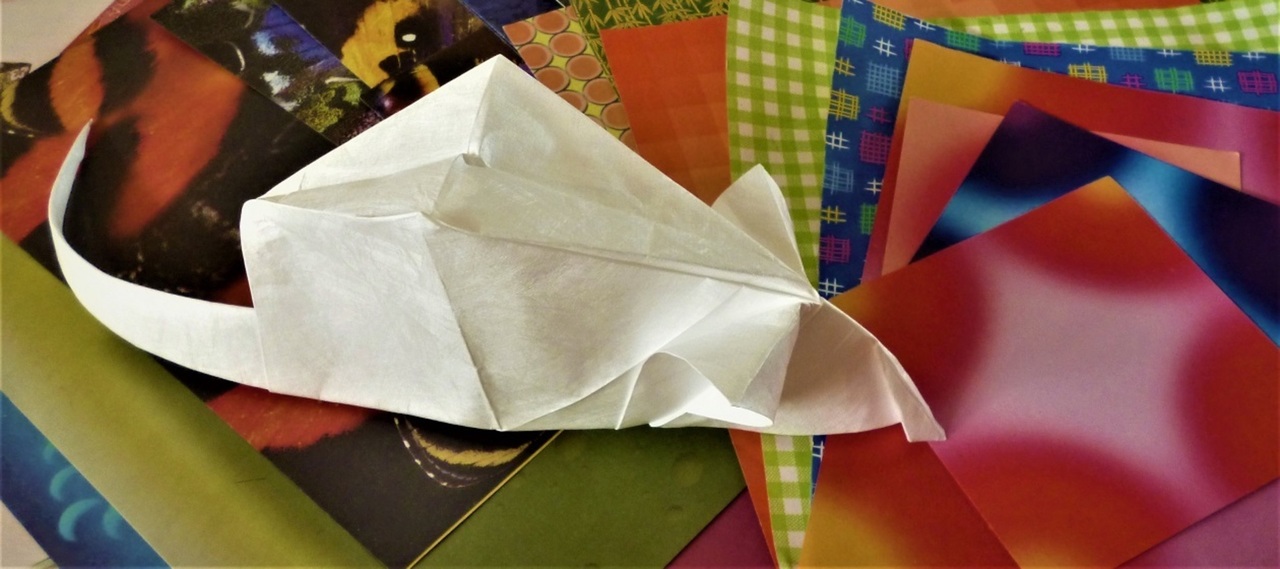
The folds on the surface of the paper are like secret letters that were formed simultaneously with the world. However, understanding what literally lies on the surface is sometimes more difficult than unraveling the depths of space.
Most likely, before the invention of paper, figures were also able to be folded, for example, from the bark or leaves of plants, and today foil and glued fabric can successfully replace it. But the art of origami could not arise outside the culture of space, without writing and mathematics, without the general development of intellectual life. This is where the value of paper is undeniable.
WHEN THERE WAS NO PAPER
To appreciate the place that a modest paper sheet occupies in human culture, it is enough to imagine a fantastic scenario: a new virus destroys all paper stocks on Earth. Documents, paper money, maps and schedules, telephone books disappear overnight. Archives and libraries are burning… Isn’t it a terrible prospect.
Fortunately, paper is somewhat more reliable than electronic media. Deficiency does not threaten her either. However, there was a time when there was no paper at all. It was replaced by bamboo and wooden planks, birch bark, wax and clay for cuneiform writing. One can imagine the contents of a diary the size of a woodpile or a whole cartload of crockery. Flattening and compression of storage media has always been valued. Therefore, the appearance of paper and the possession of the secret of its production at one time determined the history of peoples and cultures in the same way as the discovery of atomic energy and cybernetics in the 20th century.
DEVELOPING OF PAPER
Modern archaeological finds indicate that the first “primitive paper” appeared almost two centuries before our era. The idea of making paper could have been suggested by thin felt produced in Central Asia. Woolen fibers are randomly intertwined in felt, and plant fibers are twisted in paper, forming a uniform surface. The raw materials for paper were dilapidated fabrics, old fishing nets, ropes and silkworm cocoon waste. They were soaked and rubbed to form a uniform slurry, which was cast on a flat and smooth stone, and pressed down with another stone from above.
The first mention of “real” paper was left by the Chinese court dignitary and inventor Cai Lun in 105 AD. He suggested crushing plant fibers together with rags in a stone mortar, and filtering the liquid fibrous mass diluted with water using a sieve. The main raw materials for paper production in China were hemp, bamboo and mulberry (paper) tree bast. Crushed, pounded and evenly distributed on a sieve, the suspension was thrown back onto smooth boards, which were then tied into piles and placed under oppression. Aligned and dried sheets were separated and finally dried.
The exact recipe for making paper was kept secret. Only in 610 AD. according to the “Japanese Chronicles” (Nihongi), the Buddhist monk Dan Ho taught this technology to Japanese masters. Soon, Japanese paper surpassed Chinese designs in quality. For the manufacture of paper in Japan, first hemp was used, then the bast of the paper tree – “kozo” (Broussonetia kazinoki), as well as wild shrubs “gambi” (from the fragrant daphne family) and “mitsumata” (Edgeworthia papyrifera). Having reached high strength, paper was first used exclusively in sacred rituals (boxes “sanbo” and envelopes “carry”), and then for the manufacture of fans, screens, umbrellas, clothes, windows and doors. To this day, Japan has preserved the technology of hand-made paper “washi” (和紙). Traditional grades of Japanese paper are distinguished by their special durability and a variety of shades of color, ornaments, embossing and inclusions.
In 751, captive Chinese paper makers betrayed their secret to the Arab Caliph. Samarkand became the new center of paper production. From here it moved to Asia Minor and North Africa, in 1150 it came to Spain, in which the Japanese primacy of the invention of origami is now being strongly contested. Later, the paper recipe came to Italy, to Central and Northern Europe. History has preserved the name of one of the first European paper makers, the Nuremberg merchant Ulman Stromer, who opened a paper mill in 1389. Independent production of paper and book printing contributed to the development of the culture of the European Renaissance.
TECHNOLOGY DEVELOPMENT
Unlike Chinese technology, rags were used in European production. After washing and fermentation, it was crushed in paper mills. A wooden frame with a bronze mesh was immersed in the liquid mass. The fibers stuck together in a thin layer and were freed from water. Thin paper layers were placed between pieces of cloth or felt plates, pressed on a screw press, dried, glued, dried again and smoothed. In 1670, the Dutch invented a grinding apparatus – a roll, thanks to which the production of paper pulp was accelerated. In the 19th century, the composition of paper changed thanks to the French physicist René Antoine Réaumur (1683-1757), who discovered in 1719 that wasps obtain a material similar to paper from plant fibers. In 1845 the Saxon weaver Friedrich Gottlob Keller (1816-1895) filed a patent for a wood abrasion device.
Now 90% of the world’s pulp is produced by the sulphate process, using alkali, mostly from softwood. The fibers are freed from lignin, which gives the wood strength and a brownish tint. In addition to cellulose, paper contains wood pulp, waste paper, rags, glue, kaolin, chalk, talc, titanium dioxide, hydrophobic substances and other fillers that improve the printing properties of paper, make it smooth and durable.
In 1799 Frenchman Louis-Nicolas Robert (1761-1828) patented a steam-powered paper machine. Over two centuries of machine improvement, the roll width has increased from 0.64 to 9 meters, and the speed of paper web production has increased from 10 to 2000 meters per minute. Contrary to forecasts of a reduction in paper production due to the development of electronic storage media, its consumption in developed countries has doubled in the 10 years after the start of the computer boom. About 330 million tons of paper and cardboard are produced annually in the world, which is an average of 50 kg per inhabitant of the planet.
As a result of all these changes, not all modern paper, even if it says “for origami”, is really suitable for folding.
FOLDING PAPER
Of all the variety of varieties, origami paper should differ not so much in the decorative and printing beauty of texture, color and ornament, but in its design and technical properties. The paper should not be glossy, as the gloss increases eye fatigue and makes occasional dents more noticeable, ruining the overall impression of the finished figure. It is desirable that the sheet has a different color on both sides, or at least it is painted on only one side, leaving the reverse side white. Otherwise, reading traditional charts, in which the polar sides of the sheet are indicated in different colors, will become more difficult with each new step. This is especially important for beginner origamists, as well as for preliminary sketch folding. The thickness of the paper should be appropriate for the size of the sheet and the complexity of the figure, and the surface of the sheet should easily bend, fold, remember the crease, and rotate 180°. For example, for a sheet measuring 20×20 cm, the thickness of the paper is usually 60–80 g/m², for microscopic figures, a miniature and extremely thin sheet is needed, and for giant sculptures, strong cardboard and additional reinforcement with metal inserts are required. A more labor-intensive figure contains more folds, the sheet is compressed more densely, and therefore the paper must be thinner or wider than that of a simple figure.
Origami paper should have a long-fiber structure, high sizing and calendering (compacting), so that it becomes elastic and durable. Its reliability can be checked using a special test. For this, a narrow paper tape is cut, about two centimeters wide. Grasping the edges and slightly pulling the strip, you should twist it like turning the handle from a spinning reel and at the same time count the number of revolutions before breaking. Strong paper can withstand more than 50 rotations, while weak paper tears after 10 rotations or less. After tearing the sheet, fluffy edges indicate the presence of long fibers that reinforce the structure of the paper.
In addition to the strength of origami paper, it is required to maintain its shape, as if it were folded from foil. To check this quality, it is necessary, having carefully smoothed out the fold, check the angle of the folded edge. Good paper can be called if the folded edge remains almost in the same plane with the main sheet. In the opposite case, loose or rather “plump”, insufficiently compacted paper will begin to spring, and the figure will fall apart into a shapeless lump. For especially complex models, handmade paper is sometimes made, “sandwiches” are made from sheets of paper glued with foil. To avoid breaks in the places of multi-layered folds, the surface of the paper is slightly moistened.
For origami, some types of wrapping paper, bookbinding varieties of designer collections, and even money are used. Banknotes experience daily loads and can be considered the standard of strength. To do this, they include cotton and linen fibers. A lot of figures have been invented that are specially made up of paper money from different countries, and words, numbers, drawings and textures are usually used for additional decorative expressiveness.
Paper is irreplaceable. It may seem that the variety of modern materials assigns it a secondary role. In fact, its uniqueness lies not so much in its cheapness and availability, but in a special design property – a combination of high strength with simultaneous flexibility of a non-woven material pressed from the finest fibers, which, regardless of their origin, are elastic like a web. In addition to cellulose, synthetic fibers are also used for paper production, which, reproducing the texture and properties of their natural predecessor, gives paper considerable strength and moisture resistance. Since the 1960s, synthetic paper has been produced on conventional paper machines from polyethylene or polypropylene. In principle, paper can be made from mineral fibers, metal and glass wool, carbon nanotubes. Fire retardant paper is produced. Such paper complies with fire safety rules and is used to create openwork shades, in the design of advertising exhibition stands and modern interiors, complementing them with folded shapes.
You may notice that the folding methods must be different depending on the type of paper. But why? What is the folding mechanism? Unlike fabric, plastic, and metal, paper has little to no stretch and remains relatively flat and flat. In the place where the fold line lies, the fibers are even more compressed and compacted. “Wrinkling” forms the difference in pressure on the outer and reverse side of the sheet. The adhesive is partially destroyed and the fibers are released. Along the fold line, the sheet becomes softer and, as it were, “remembers” the fold, repeating the movement in the same place like a piano loop.
Another reason for the appearance of a fold is associated with the destruction of not the glue, but the fibers themselves. In a flat sheet, the fibers are located in different directions, and when broken, some of the fibers located across the fold line are torn, while the fibers directed along the fold are twisted like a spring, remaining intact.
There is a third, most common cause of the fold. A paper sheet, in addition to fibers, glue and various dense additives, contains air. In other words, the thickness of the sheet depends primarily on the fibers that reinforce the sheet, located not in a plane, but at an angle and across the paper plate. When a fold is pressed through, the layer of paper along it becomes thinner due to the fibers, which flatten.
Some types of polymers have a similar property. In the place of the crease, the polymer sheet becomes thinner and, due to the elasticity of the material, reproduces the crease during the next bending. Creasing can be used to improve the accuracy of folding paper, cardboard, glued fabric, plastic or metal. To do this, at the site of the future fold, a sheet is compacted with a roller or a blunt knife, similar to a groove. Folding the creased sheet requires much less effort and care.
Machine creasing is widely used in printing and cardboard production. Adjacent edges forming a stiffening rib, as in a metal corner, give the folded sheet additional stability, due to which the boxes withstand heavy loads and prevent damage to the packaged goods. The structural properties of paper are often replicated in stronger materials and compounds, and paper remains indispensable for modeling kinetic forms in architecture, design, and industrial technology.
Summing up, it can be noted that the experience of folding paper into a wide variety of forms taught our scientists and designers, designers and other engineers a lot.
And, of course, paper is still the best material for translating the human imagination into figures of the amazing art of origami folding.





